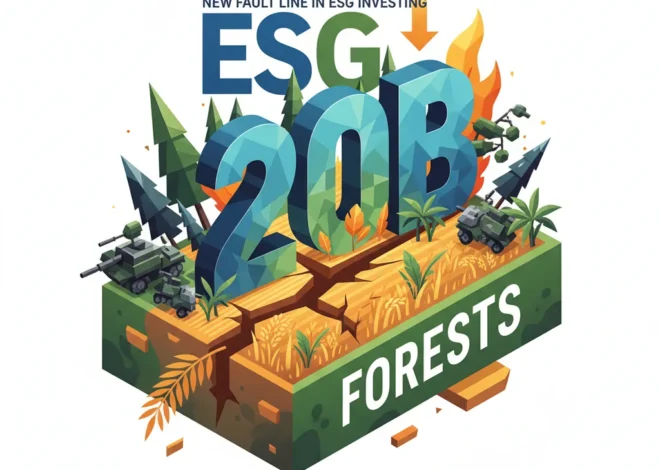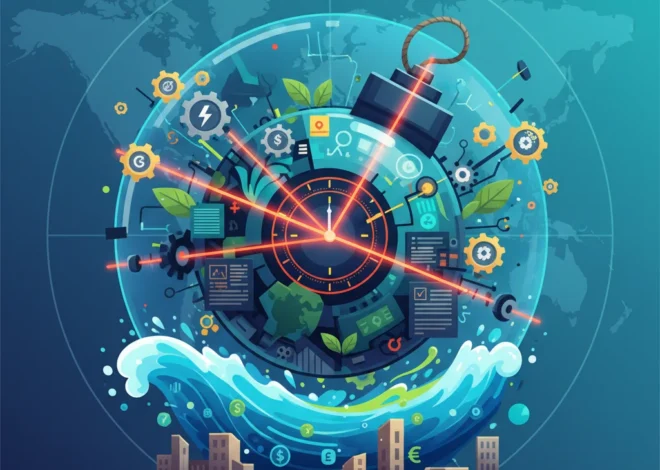
Amazon’s Crossroads: Why COP30 in Belém is a High-Stakes Gamble for Global Finance
In November 2025, the world’s attention will turn not to a gleaming metropolis like Dubai or Paris, but to Belém, a city of 1.3 million people at the mouth of the Amazon River. As the host of the 30th UN Climate Change conference (COP30), this Brazilian port city will become the epicenter of global climate policy. But this is more than just a change of scenery. Holding the summit in the heart of the world’s largest rainforest is a powerful, deliberate statement. It forces a direct confrontation with the planet’s most urgent environmental crisis and poses a critical question to the world of finance, investing, and economics: can we finally put a viable economic value on nature before it’s too late?
For investors, business leaders, and financial professionals, COP30 is not just another line item on the ESG calendar. It represents a potential inflection point for the global economy. The decisions made in Belém will ripple through the stock market, influence banking regulations, shape new forms of trading, and redefine the very economics of sustainability. This isn’t about distant polar bears; it’s about portfolio risk, supply chain stability, and the creation of entirely new asset classes. The Amazon is about to become the world’s most significant boardroom.
The Belém Paradox: A Microcosm of a Global Challenge
The choice of Belém is both inspired and fraught with complexity. Symbolically, it’s a masterstroke by Brazilian President Luiz Inácio Lula da Silva, forcing delegates to look out their hotel windows at the very ecosystem they are there to protect. Yet, the logistical challenge of hosting an estimated 50,000 visitors in a city with developing infrastructure highlights the central paradox of the climate debate: the immense gap between ambition and reality. Helder Barbalho, the governor of Pará state, has acknowledged the “great challenge” of preparing the city, a task that involves everything from expanding the airport to dredging the local bay for cruise ships to serve as floating hotels.
This local struggle is a mirror of the global one. We have the ambition to decarbonize, but do we have the infrastructure, the investment, and the political will to execute? For Brazil, this is a national test. President Lula is staking significant political capital on positioning the country as a climate leader, a stark reversal from the policies of his predecessor. His vision is to pivot the region’s economy away from destructive practices like illegal logging and mining towards a sustainable “bioeconomy.” This transition, however, requires a colossal injection of capital, a challenge that local and national budgets cannot meet alone. This is where global finance enters the narrative.
The Billion Insurance Shake-Up: Why Private Capital is Targeting Brighthouse Financial
Financing the Forest: From Abstract Pledges to Investable Assets
For decades, conversations about saving the Amazon have been dominated by government aid and philanthropic donations. While important, this approach has proven insufficient to combat the powerful economic forces driving deforestation. COP30 aims to shift the paradigm, focusing on market-based mechanisms and large-scale private investing. The key is to create financial instruments that make a living forest more profitable than a dead one.
Several key financial concepts will dominate the discussions in Belém:
- Carbon Markets: The idea of trading carbon credits is not new, but efforts to create a robust, transparent global market have been halting. Brazil, with its vast forests, could become a “carbon superpower,” supplying high-quality credits to companies and countries needing to offset their emissions. Success hinges on establishing trust and verification, ensuring that each credit represents a real, verifiable tonne of avoided CO2.
- Green Bonds and Debt-for-Nature Swaps: These instruments allow countries to refinance their debt on favorable terms in exchange for commitments to conservation. This directly links sovereign finance with environmental outcomes, a powerful tool for emerging economies. Global banking institutions will be crucial in structuring and underwriting these deals.
- The “Bioeconomy”: This is the most ambitious concept. It involves creating new industries based on the sustainable harvesting of the Amazon’s biodiversity—from pharmaceuticals and cosmetics to advanced materials and sustainable agriculture. This requires venture capital-style investing in research, development, and scalable business models.
The following table outlines the primary stakeholders involved in financing this transition and their core interests, illustrating the complex interplay between public policy and private capital.
| Stakeholder | Primary Role & Objective | Key Financial Instruments |
|---|---|---|
| Brazilian Government | Set policy, enforce regulations, and attract foreign investment. Objective: Balance economic growth with environmental preservation. | Sovereign Green Bonds, Carbon Tax/Market Legislation, Public-Private Partnerships (PPPs). |
| Multilateral Development Banks (e.g., World Bank, IDB) | Provide low-cost capital, de-risk projects for private investors, and offer technical assistance. Objective: Facilitate sustainable infrastructure development. | Concessional Loans, Blended Finance, Project Guarantees. |
| Private Equity & Venture Capital | Fund early-stage bioeconomy startups and scalable sustainable businesses. Objective: High-growth returns from innovative green technologies. | Equity Investments, Venture Funding for R&D. |
| Asset Managers & Institutional Investors | Allocate capital from pension funds, insurers, etc., into large-scale projects. Objective: Stable, long-term returns that meet ESG mandates. | Infrastructure Funds, Green Bonds, Public Equities in sustainable companies. |
| Fintech & Technology Companies | Provide the technological backbone for transparency and efficiency. Objective: Create new markets and platforms for green assets. | Blockchain for supply chain tracking, AI for satellite monitoring, Digital platforms for carbon trading. |
The Role of Financial Technology in Building Trust
The greatest barrier to investing in natural capital has always been a lack of trust and transparency. How can an investor in New York or Tokyo be certain that their money is genuinely preventing deforestation on the ground in Brazil? This is where financial technology, or fintech, becomes a critical enabler. The abstract economics of conservation can be made tangible through technology.
Consider the application of blockchain. A transparent, immutable ledger can be used to track the entire lifecycle of a carbon credit, from its creation via satellite-verified forest preservation to its retirement by a corporation. This eliminates the risk of double-counting and fraud that has plagued early carbon markets. Similarly, blockchain can provide unprecedented transparency in supply chains. A company could trace a shipment of açaí berries or Brazil nuts from a specific, certified sustainable co-op in the Amazon directly to a supermarket shelf in Europe, proving its deforestation-free origins to consumers and regulators. This isn’t science fiction; it’s the application of existing financial technology to an ecological problem.
This technological layer is essential for unlocking institutional-scale investing. It transforms a high-risk, opaque donation into a verifiable, tradable, and auditable asset. It’s the bridge that connects the world’s largest pools of capital with the world’s most critical ecosystem.
Puma's Painful Pivot: Can 900 Job Cuts Close the Gap on Nike and Adidas?
Implications for the Global Economy and Your Portfolio
The outcomes of COP30 will have far-reaching implications. A successful summit that establishes clear rules for carbon trading and a framework for the bioeconomy could trigger a significant flow of capital into Brazil and other rainforest nations. This could boost their economies, stabilize their currencies, and create new sectors for growth.
For investors, this presents both opportunities and risks. Companies that are leaders in sustainable agriculture, renewable materials, and green technology could see their valuations soar. The establishment of a liquid, global carbon market would create an entirely new asset class for trading. Conversely, businesses that rely on supply chains linked to deforestation will face immense regulatory and reputational risk. The financial and stock market landscape could be reshaped as the “E” in ESG (Environmental, Social, and Governance) investing gains sharp, quantifiable teeth.
As Izabella Teixeira, a former Brazilian environment minister, noted, the goal is to “bring the Amazon to the world and the world to the Amazon” (source). For the financial world, this means bringing the tools of modern finance—data analytics, risk management, sophisticated trading platforms, and innovative financial technology—to bear on one of humanity’s oldest and most complex challenges.
COP30 in Belém is more than a conference; it’s a real-world test case. It will determine whether our global financial system is agile and creative enough to price nature’s value correctly. The world of finance has the capital and the tools. The Amazon provides the ultimate test of its purpose. The stakes, for the planet and for our portfolios, have never been higher.
The Future Is Tradable: How Crypto ETPs Are Making Bitcoin and Ethereum Investing Simple and Secure


